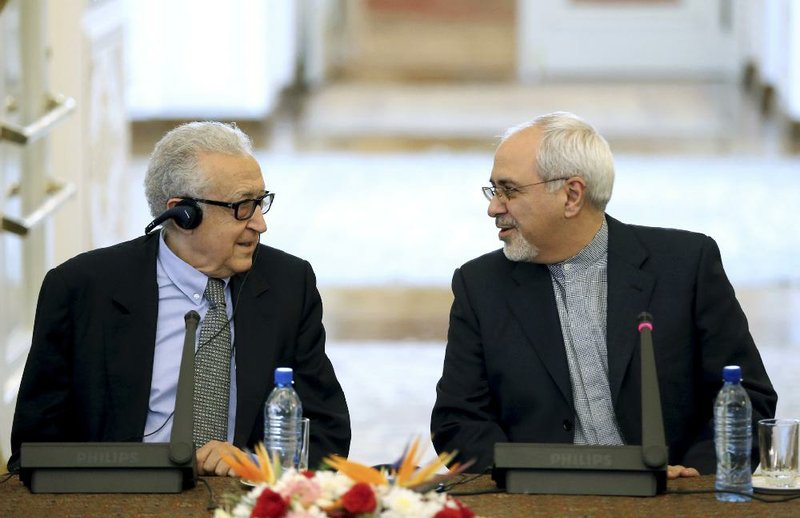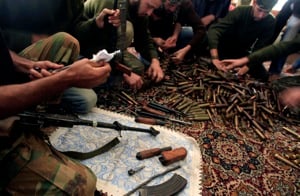GENEVA - Syria submitted a formal declaration of its chemical-weapons program and plans for destroying its arsenal three days ahead of the deadline, the international chemical-weapons watchdog said Sunday.
The Organization for the Prohibition of Chemical Weapons, which is charged with monitoring and destroying Syria’s chemical-weapons program, said that it received the Syrian submission Thursday.
It has not yet been decided how or where destruction of Syria’s chemical weapons will happen. Damascus’ declaration includes a general plan for destruction that will be considered by the agency’s 41-nation executive council Nov. 15.
It also was not immediately clear whether the declaration’s listing of Syria’s chemical-weapons sites was exhaustive, an important test of President Bashar Assad’s willingness to cooperate with the program to eliminate the country’s chemical-weapons infrastructure and arsenal.
Saying that such declarations are confidential, the agency declined to disclose or discuss the contents of the Syrian document.
U.S. officials said in September that Syria’s chemical-weapons program included at least 45 sites. But when Syria submitted a preliminary declaration of its chemical-weapons program that month, it declared only 23 sites.
The State Department has never fully explained the discrepancy. Some of the gap, U.S. officials have suggested, may reflect efforts by the Syrians to consolidate their chemical-weapons stocks, as well as the haste in which the Assad government compiled its initial list.
But U.S. officials also have suggested that Syria’s preliminary declaration was not complete and stressed the need for the Assad government to do better in the formal declaration.
“It is of the greatest importance that that document be complete,” a senior State Department official said this month.
The United States has a number of ways to make its concerns about Syrian compliance known, including by direct contact with Syrian officials. However, President Barack Obama’s administration is largely counting on the Russians to use their influence with Assad to persuade him to comply.
The initiative to eliminate Syria’s chemical-weapons program came from the Russians, who were looking for a way to protect the Assad government from a U.S.-led airstrike that the White House had threatened after a chemical-weapons attack in a suburb of Damascus on Aug. 21. The U.S. has said the Syrian regime was responsible.
U.S. and Russian officials hammered out the details of a disarmament plan in Geneva in September. Later that month, the United Nations Security Council adopted a resolution that required Syria to give up its arms.
That measure noted that if Syria failed to cooperate, the Security Council could take measures under Chapter 7 of the U.N. Charter, the strongest form of a council resolution. Such steps could include economic sanctions or even military action. Before any action could be taken, the issue would have to return to the Security Council for further deliberations; Russia, like the other permanent members, holds a veto on the council.
Syria also submitted a declaration covering activities and facilities that are not prohibited under the Chemical Weapons Convention, the chemical-weapons agency said Sunday. The declaration can be subjected to routine verification measures as a confidence-building measure and to establish the peaceful intent of commercial activities, the agency said.
Syria’s declaration arrived as the chemical-weapons agency, which is based in The Hague, said its inspectors had visited 19 of the 23 chemical-weapons sites thatSyria initially listed and had completed the destruction of equipment for mixing chemical agents and loading weapons at the sites.
Michael Luhan, a spokesman for the agency, said that by Thursday, Syria would “no longer have the capability to produce any more chemical weapons, and it will no longer have any working equipment to mix and to fill chemical weapons agent into munitions.”
Patricia Lewis, research director for international security at Chatham House in London, said “the priority for the inspectors was to prevent another mass attack” using chemical weapons.
“They have clearly achieved a large proportion of what they needed to do in that respect,” she added.
The goal of eliminating Syria’s chemical-weapons arsenal and capabilities by mid-2014, however, remains a formidable one.
With inspectors moving toward completing the first round of the program, attention is shifting to the task of destroying an arsenal estimated to include 1,000 tons of precursor chemicals and nerve agents.
The U.S. has proposed shipping part of Syria’s chemical stocks for destruction to other countries and has approached a number of governments.
The complexity of such arrangements became apparent last week, when Norway said it had turned down a U.S. request that it participate, citing “time constraints and external factors, such as capacities, regulatory requirements.”
Norwegian Foreign Minister Boerge Brende said the country lacked the necessary equipment and that the mid-2014 deadline was too tight.
Meanwhile, fighting in Syria raged on, with Al-Qaidalinked rebels battling government troops for control of the Christian town of Sadad north of Damascus, activists said.
The rebels have been trying to seize the town for the past week, and residents in the rebel-held western neighborhoods of Sadad are trapped in their homes, said Rami Abdurrahman of the Britain-based Syrian Observatory of Human Rights.
The rebels appear to have targeted Sadad because of its strategic location near the main highway north from Damascus rather than because it is inhabited primarily by Christians. But extremists among the rebels are hostile to Syria’s Christians, which have largely backed President Bashar Assad during the conflict.
The official Syrian news agency said troops wrested back control of eastern parts of Sadad, but were clashing in other areas.
Also Sunday, Syrian Kurdish gunmen were trying to secure their hold over a major border crossing with Iraq after capturing the Yaaroubiyeh post in northeast Syria on Saturday. Abdurrahman said the Kurdish gunmen were fighting pockets of fighters from extremist rebel groups in southern Yaaroubiyeh.
Syria’s conflict, now in its third year, has pitted Assad’s forces against a disunited array of rebel factions. Al-Qaidalinked hard-liners have fought other rebel groups as well as Kurdish militias who have taken advantage of the government’s weakness to cement control over territory dominated by the ethnic minority.
Information for this article was contributed by Nick Cumming-Bruce and Michael R. Gordon of The New York Times; by Diaa Hadid, Mike Corder and Sameer N.Yacoub of The Associated Press; and by Glen Carey of Bloomberg News.
Front Section, Pages 1 on 10/28/2013

